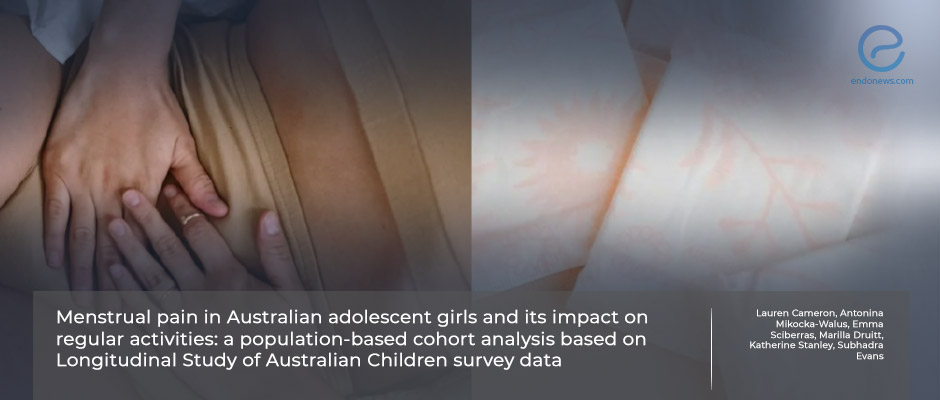Dysmenorrhea in adolescent girls and the quality of life
Jun 12, 2024
Pain during menstruation results in abstinence from work or school among adolescents.
Key Points
Highlights
- The earlier the dysmenorrhea in adolescents, the more intense the experience of painful menstruation.
Importance:
- Proper management of dysmenorrhea is important to impair school and/or work engagement in adolescent girls resulting in improvement of quality of life.
What’s done here?
- This prospective, population-based cohort study was conducted to evaluate the incidence of dysmenorrhea in Australian adolescent girls and to determine the association between pain severity and missing regular daily activities.
- Longitudinal survey data was evaluated for 2014–2018 for Kinder cohort participants at waves 6 (mean age 14 years), 7 (16 years), and 8 (18 years).
- Questions about menstruation and menstrual pain, their menstrual cycles during the previous three months including regularity and the method of contraception were asked.
- Abstinence from work or school, social activities, sports, or exercise in the recent three months because of their periods was questioned.
Key results:
- Dysmenorrhea was determined as 35%, 50%, and 46% at waves 6,7 and 8, respectively.
- Severe pain during periods was encountered in 79 of 644 participants (12%) at wave 6, 307 out of 1341 (23%) at wave 7, and 203 out of 1115 (18%) at wave 8.
- There was no significant association between oral contraceptive pill use and the severity of dysmenorrhea at any wave.
- Of those, 34% of the participants reported missing at least one activity at wave 6 while 34% and 31% reported abstinence from work or school at wave 7 and 8, respectively.
- Adolescents having dysmenorrhea were more likely to miss school or university compared with those without dysmenorrhea.
- As the degree of pain severity during menstruation increased, the possibility of missing activity increased.
Limitations:
- Some restrictions in the survey questionnaire such as non-determination of age at menarche or non-differentiation of the exact underlying reason for missing activities are the limitations.
- Another limitation was the lack of understanding of whether birth control pills were used for pain other than the prevention of pregnancy.
Lay Summary
Dysmenorrhea, also known as period pain, painful periods, or menstrual cramps, is pain during menstruation. Despite its high incidence, dysmenorrhea is often a stigmatized and normalized condition. However, it is known that painful periods cause abstinence from work or school resulting in decreased quality of daily life.
Cameron et al. from Australia, published a study titled “Menstrual pain in Australian adolescent girls and its impact on regular activities: a population-based cohort analysis based on Longitudinal Study of Australian Children survey data” in the journal The Medical Journal of Australia. The incidence of dysmenorrhea in Australian adolescent girls was evaluated in this prospective, population-based cohort study and the association between pain severity and missing regular daily activities was investigated. The survey questionnaire was applied to Australian adolescents at waves 6 (mean age 14 years), 7 (16 years), and 8 (18 years) including questions about menstruation and menstrual pain, their menstrual cycles during the previous three months including regularity and the method of contraception. In addition, abstinence from work or school, social activities, sports, or exercise in the past three months because of their periods was questioned.
Dysmenorrhea was determined as 35%, 50%, and 46% at waves 6,7 and 8, respectively. Severe pain during periods was encountered in 79 of 644 participants (12%) at wave 6, 307 of 1341 (23%) at wave 7, and 203 of 1115 (18%) at wave 8. Of those, 34% of the participants reported missing at least one activity at wave 6 while 34% and 31% reported abstinence from work or school at wave 7 and 8, respectively. Adolescents having dysmenorrhea were more likely to miss school or university compared with those without dysmenorrhea. As the degree of pain severity during menstruation increased, the possibility of missing activity increased.
“Recognising adolescent period pain is important not only for enhancing their immediate quality of life with appropriate support and interventions but also as part of early screening for chronic health conditions such as endometriosis,” they added.
Research Source: https://pubmed.ncbi.nlm.nih.gov/38717022/
endometriosis dysmenorrhea period pain questionnaire abstinence

